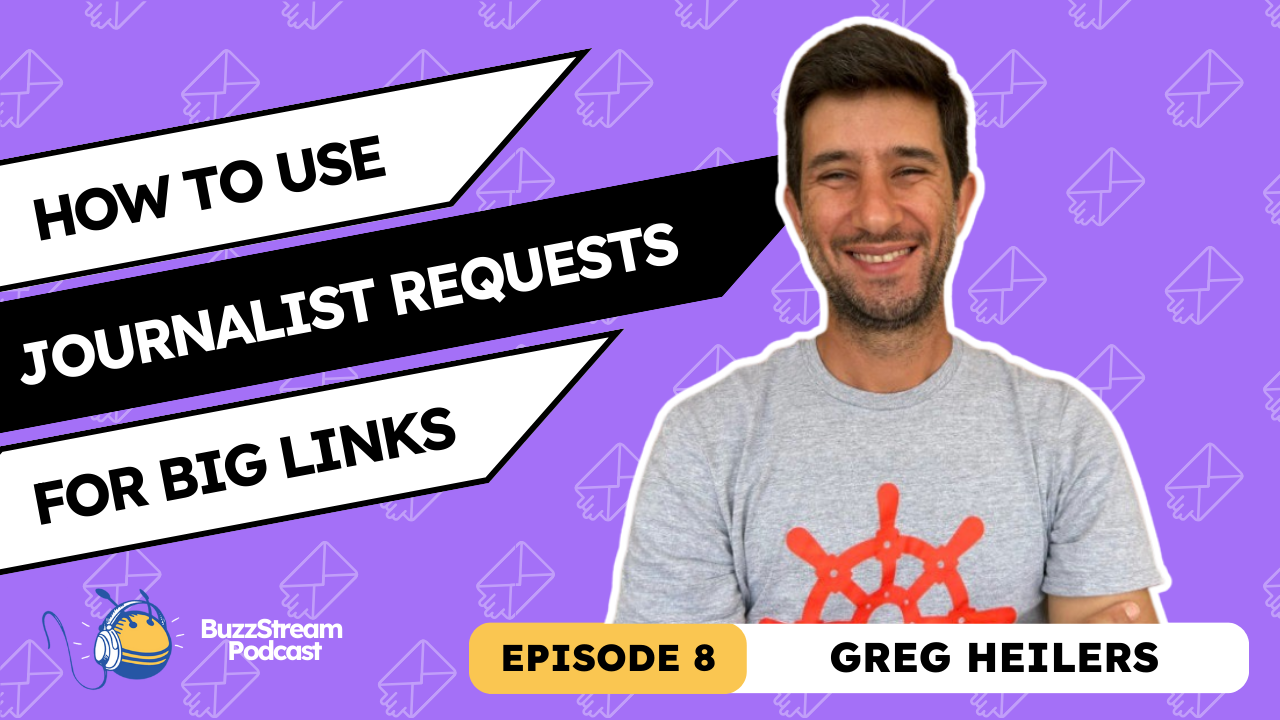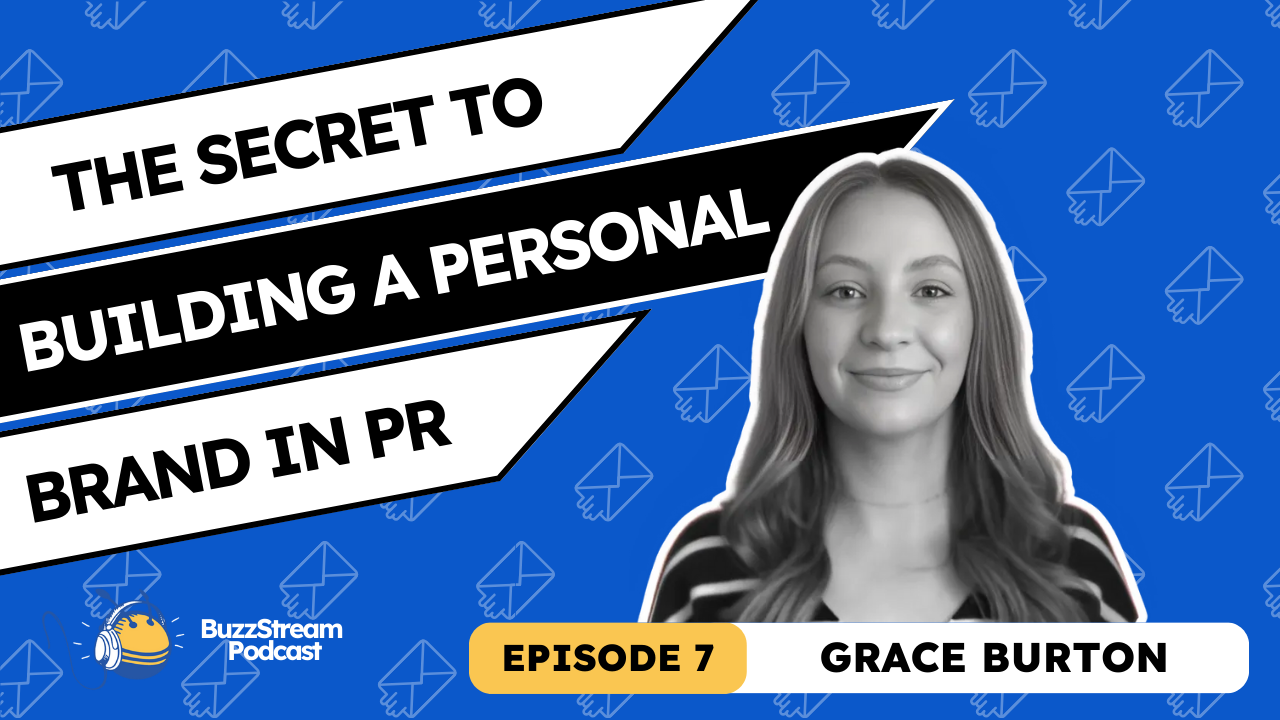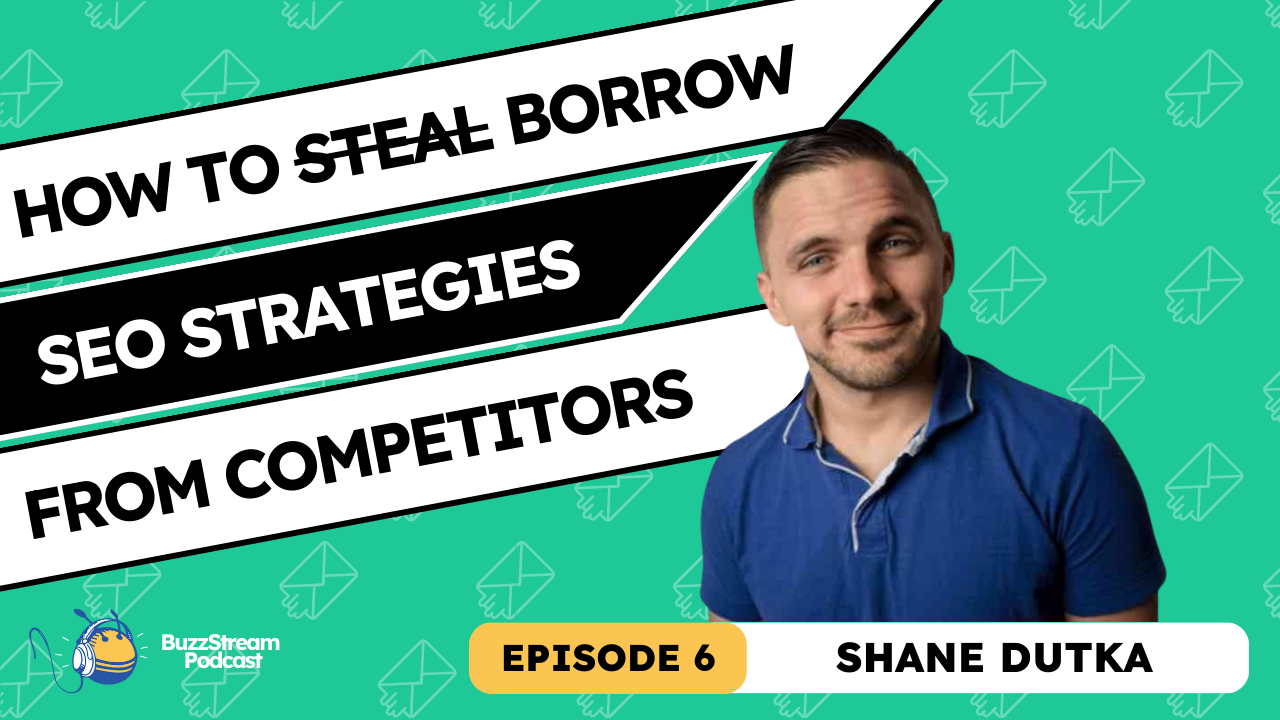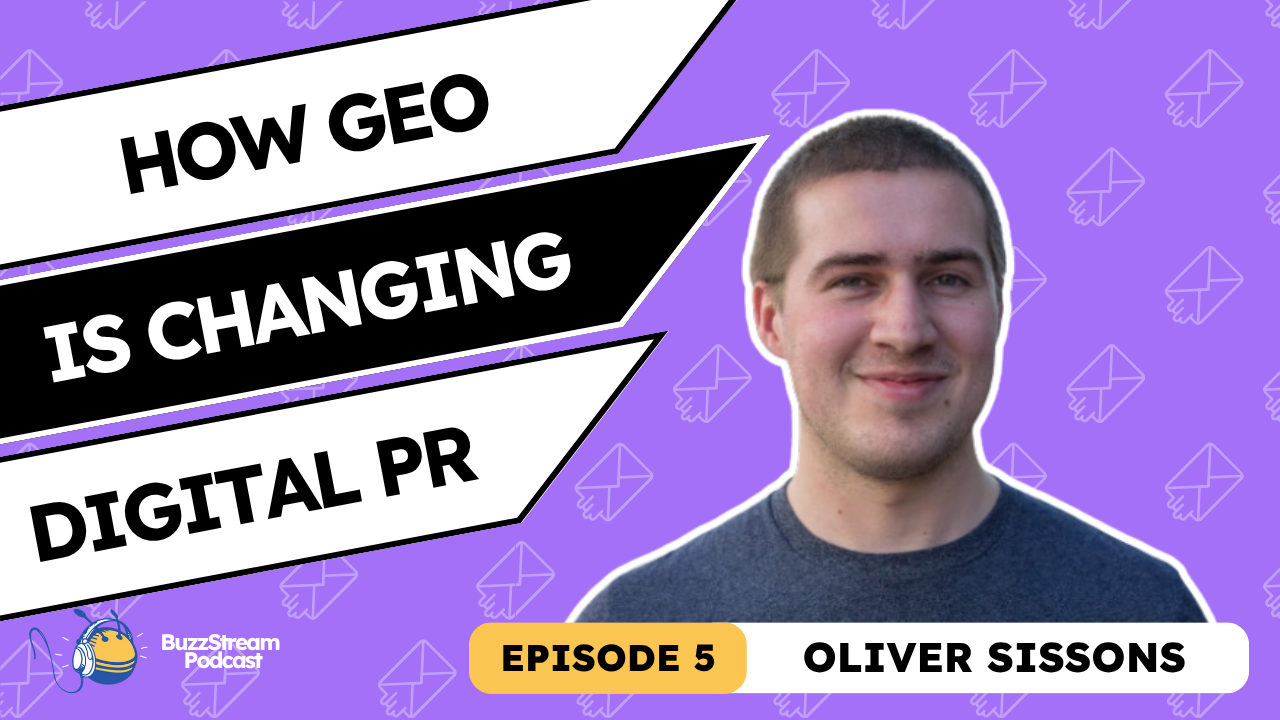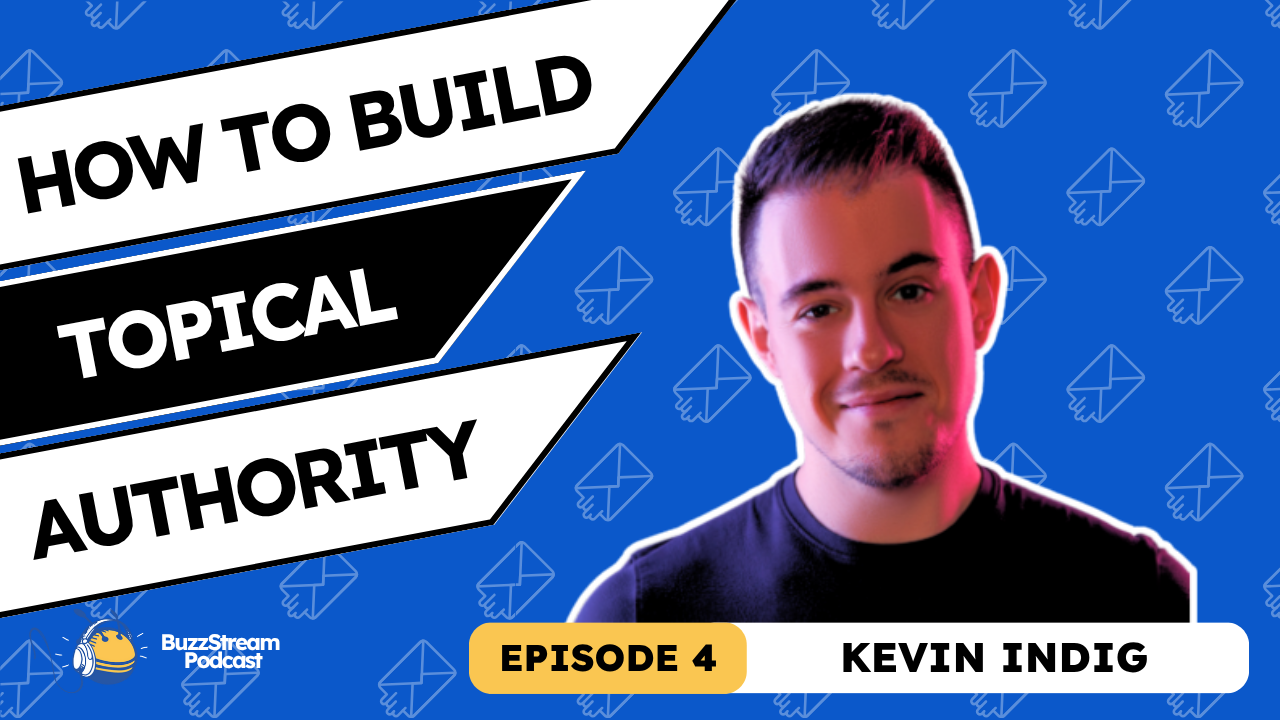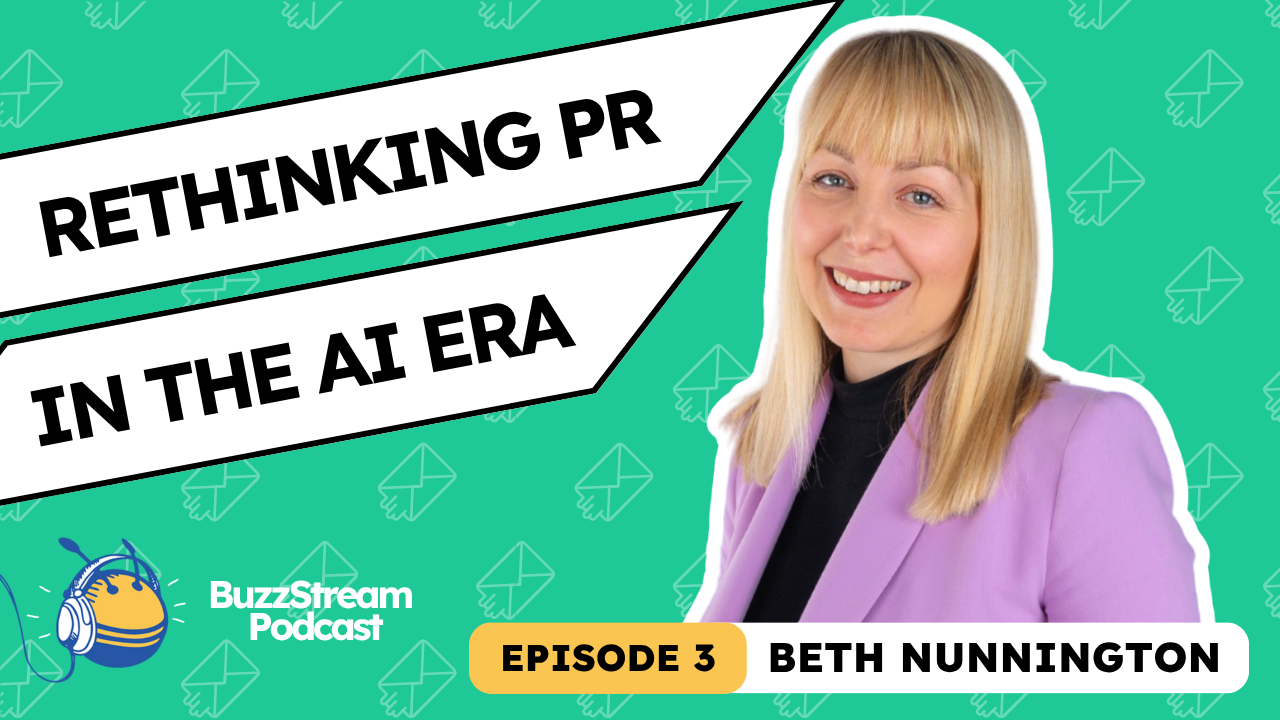Table of Contents
I came across Mark Rofe on X after announcing he was starting a newsletter named DigitalPRNewsletter.com.
I dug in a bit more to find that Mark has had a prolific career in digital PR. He’s been involved in some of the most clever campaigns I’ve seen, including one where he took out a billboard ad to help find a companion (or at least a date).
Again, the campaign is aptly named DatingMark.co.uk. (If you check out the site, you’ll find he was featured on huge news outlets like the BBC.)
He also has a course where he teaches everything he’s learned over the years called…you guessed it…DigitalPRCourse.com.
What stood out to me was a specific edition of the newsletter in which he discussed the “Warren Buffet approach to PR.” He went on to discuss finding the sweet spot for reactive PR pitching.
I don’t want to spoil anything more because this one is full of great tips and advice from Mark about reactive digital PR.

Main Takeaways
1. Reactive PR can be divided into planned (e.g., holidays, scheduled events) and unplanned (e.g., unexpected company layoffs, natural disasters) components. Prepare for both types to maximize opportunities.
2. High-media-interest topics are likely to get more coverage but are also more competitive. Low-media-interest topics might yield fewer but more targeted placements.
3. The window of opportunity can be very short, sometimes just a few hours. Being plugged into real-time updates and having pre-prepared comments can help.
4. For planned events, prepare different potential comments in advance and get pre-approval from clients. This allows you to react instantly when the event occurs.
5. Create a list of journalists who have covered similar stories in the past. This list should be updated regularly to account for their roles or beats changes.
6. Focus on sending high-quality, relevant pitches rather than mass emailing. Tailor your pitches to the journalists‘ interests and recent work to increase the chances of coverage.
7. To ensure that the comments or insights you provide are authoritative and relevant, ask, “Would I (or your client) be comfortable talking on TV about this topic?”
8. Include relevant keywords in your email subject lines and comments. This increases the likelihood that journalists will find your past pitches when searching for sources on similar topics in the future.
How Do You Differentiate Newsjacking and Reactive PR?
Yeah, I mean, I think that’s a good question. I think they’re often used interchangeably. You know, if someone. Says newsjacking and someone says reactive PR often, they’re kind of talking about the same thing.
I think that there’s just maybe a very small difference. And I think that you know, if you were to look up newsjacking, it, it’d be something along the lines, you know, if you looked up a definition, something along the lines of, uh, piggybacking or inserting your thoughts or opinions into like a breaking news story.
So, something like that, and I think newsjacking is more about adding to or contributing to an existing story. So, if something happens, you add your thoughts or comments to it.
On the other hand, I think reactive PR is a bit wider in scope. I think it can include that. But it can also include, maybe there’s a breaking news story or something and creating a new angle or story off the back of that existing story.
So that might sound slightly confusing, but if I give you an example—um, it’s probably a really bad example—let’s say a celebrity couple gets engaged. I think an example of newsjacking would be getting a comment from an expert on the engagement.
If it’s someone in the royal family, you might get a royal expert or something to comment on that.
So I’d say that is kind of newsjacking.
Whereas I would say reactive PR would be if you had that same story, you would kind of find a new angle to it, which would be, um, maybe where they are going to get married and why, or how much is that engagement ring that they proposed with worth?
So that is a slightly different angle from that existing story. But I could also be talking absolute rubbish, but that’s how I would perceive it in my head.
Is Reactive PR a Big Part of Your Digital PR Toolkit Nowadays?
So it wasn’t initially, but I think as time has passed, it has become more and more of something I’m doing.
And maybe I can talk a little bit more about why that is, but yeah, I think, you know, if we take a step back and look at what’s been going on in the industry.
So, journalists have been being made redundant, you know, left, right, and center across the US and the UK.
And I think that, you know, I’m trying to remember the stats now, but I think there will be 8,000 journalists in the UK in 2023.
North America, including the US and Canada, was made redundant. Just this year, I think it was about a thousand in January 2024. And in February, I think it was another 600.
So basically, um, you know, this includes some pretty large companies as well, like PLC in the UK. You’ve got, uh, vice, uh, bustle. Um, LA Times, uh, business insider, they’ve all made cuts. Right. And I think when that happens, you have journalists that were, no, they’ve lost their job.
So they’re going to do a couple of things:
Some will maybe get another job in journalism. Some will become copywriters, but I don’t have any data to back this up.
I have seen, and it’s quite common, that journalists also do PR. So, you’ve got a slight imbalance.
You’ve got fewer journalists.
And now you’re adding to the PR bucket over here because some journalists are getting jobs in PR. And then you’ve also got some SEOs who, um, or, like, old school link builders or whatever you’d want to call them.
Also, having a go at doing PR, they’re having a crack at it.
So you’re adding that you’re adding those to the mix as well. With fewer journalists and more people doing PR, it’s become more competitive.
And what I think that has happened because of that is that you’ve got journalists working with basically like a skeleton crew, right? And if your story isn’t relevant now, then it’s not a priority.
So they want to be writing about stuff that is relevant right now. And a few years back, maybe you could get away with something if it wasn’t relevant right now.
You could cover that, but if you tried the same thing now, it might not work. So that’s how I see things play out.
And I think that is why, uh, across the board, you’re kind of seeing hero or creative campaigns become less effective because of a combination of all those reasons. Um, it’s not necessarily a fact, but it’s my opinion on the situation.
Have You Seen a Drop-Off in Getting Your Pitches Read?
It’s a difficult question to answer because I’m not a journalist. So I can’t, and I don’t have visibility into the inboxes.
But I can guess that there are more PR people who are sending the same or very similar stories to the same journalists or the remaining journalists.
So I think it has become more challenging to get, you know, to get cut through, which is why reactive PR is so important.
If it’s relevant now, then there’s a higher likelihood, in my opinion, that it’s going to get covered. Otherwise, it just goes to the, you know, just goes to the back of the pile.
The journalists may love your story, but it’s like, I’ve got all these other ones that I need to write right now.
You know, there’s a sense of urgency about these other ones. And they might like your story and return to it, but we’re all humans. They might also forget about it and something else might come up.
Could You Outline Your Reactive PR Matrix?
Reactive PR can generally be broken down into two components: planned or unplanned.
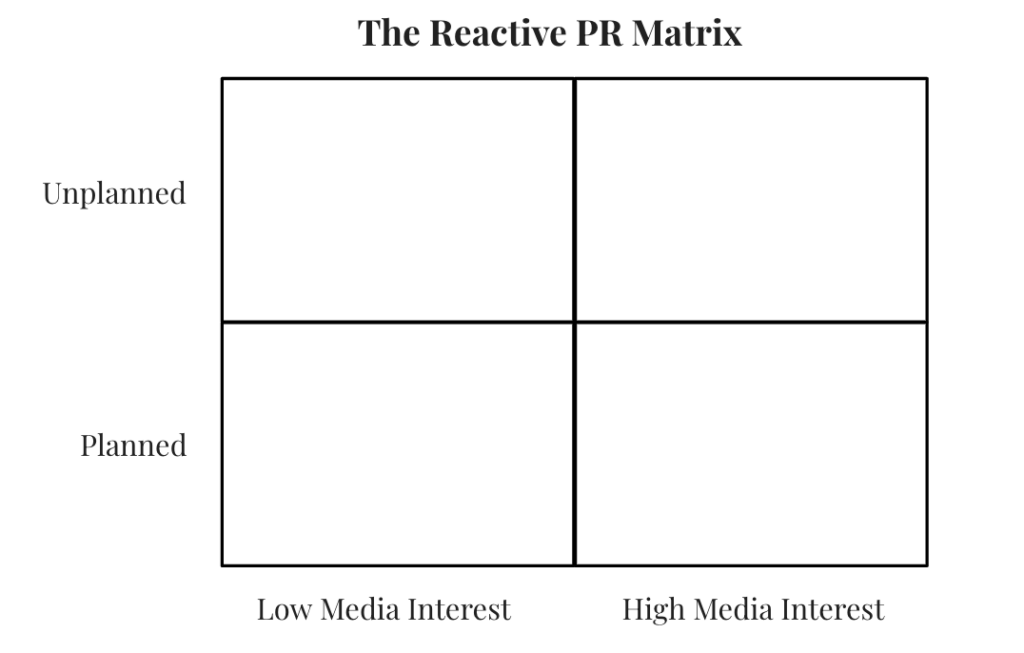
So “planned” is stuff that, you know, will happen, right?
You know, Christmas is coming, you know that pancake day or Mother’s Day or whatever is coming. So, you can plan reactive stuff in advance.
In finance, maybe that’s the budget in the UK or when the Bank of England will set interest rates. So that’s planned.
“Unplanned” would be things you have no idea will happen.
Maybe a company is going to make layoffs, or they go into an administration, or a volcano erupts, and suddenly there’s like travel chaos or, you know, anything like that, so that’s kind of planned and unplanned.
You may hear some people talk to them in a slightly different way, but they mean the same thing.
So they might mean, when they’re talking about reactive, they might talk about reactive and proactive. It’s the same thing kind of planned and unplanned.
But you can break that down further, into high or low media interest, which is basically just a way of saying how likely the news publications or whatever publications are to cover these stories.
If it’s a high media interest, lots of them will cover it.
If it’s low media interest, maybe some niche publications, like trade publications, will cover it because it’s very specific to them, or maybe regional publications will cover it because, you know, it’s happening in their region.
Would Something That’s Low Media Interest Yield Less Coverage?
I like to go for stuff that is maybe high media interest because I know there’s an appetite for it.
But, you know, conversely, someone might think that I’ll go for the, maybe, the low media appetite ones because I might be able to pick up one or two links there or pieces of coverage there because maybe no one else is kind of going for it.
The great news about planning is that you can plan for it in advance. So you can work with your client and maybe come up with comments from them in anticipation of an event that’s coming up, or you know, get sign-off and pre-approval on things.
It’s great because it’s planned.
The downside is that everyone else, all your competition, also thinks the same thing, so they can plan for it in advance.
Right. And it’s really interesting to see this play out because I’ll go back to the Bank of England interest rates example. Every month in the UK, the Bank of England sets the interest rates.
And they can either go up, stay the same, or go down. So, if you have a finance client, you might prepare three comments from them for each scenario. Then when the Bank of England makes the announcement, everyone is just sending the same thing: a comment from their client to the journalist.
I’ve seen the journalist kind of—I don’t want to say the word complain, but I guess, tweet about it and be like, Oh my God, the announcements just came out like three minutes ago, and I’ve already had 20 or 30 journalists contact me.
Screenshot below is from a journalist:
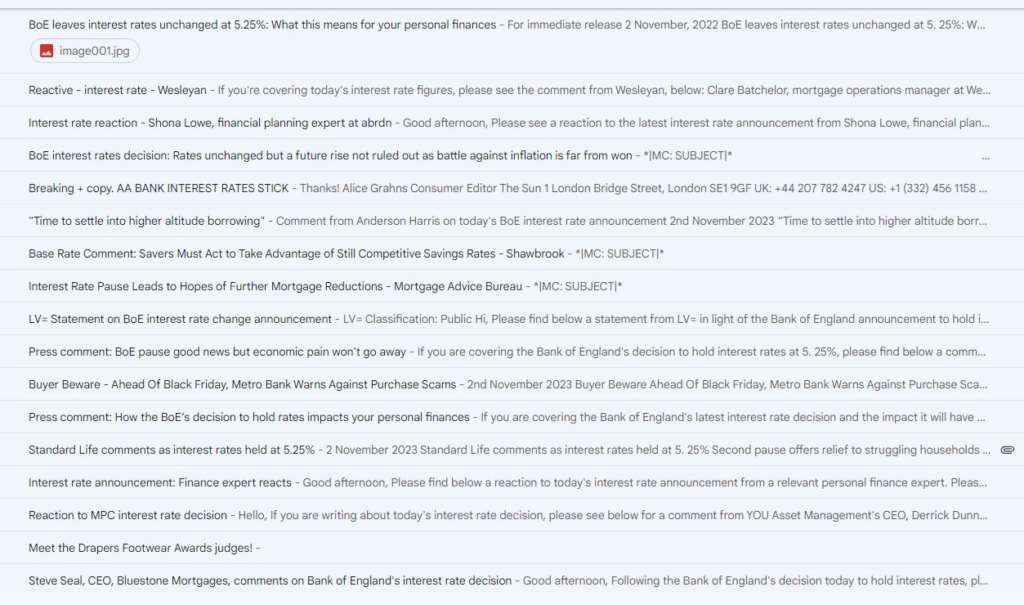
It’s really difficult in that situation to get coverage because they’re not going to be able to use all of those comments from all these different clients; they might pick one or two.
So, people are doing that and then maybe wondering why they’re not getting coverage because everyone else is doing the exact same thing.
And that is, that’s the downside to it. Right.
So I think because there is more competition now, you not only have to think about the idea that you’re doing and the execution, you have to be thinking, what is everyone else going to be doing, and you kind of have to think, okay, if it’s predictable and everyone else is going to do it, you maybe have to think, okay, we won’t do that.
And we will do something different over here. We’ll try this over here.
I mean, I would probably prefer to do something different. I like to operate in the unplanned high media interests sphere; there’s nothing wrong with any of the others.
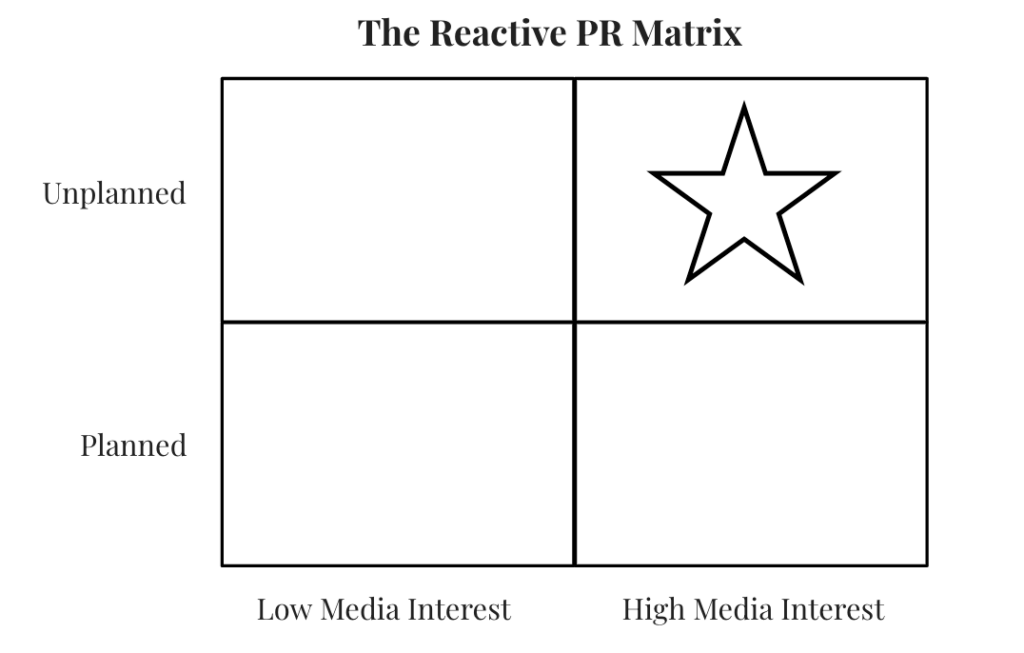
It’s just, you know, a different way of doing it.
You just probably have to accept that you’re going to have a higher chance of not succeeding and getting coverage if everyone else is doing the same thing.
And I know, I know in the newsletter, I spoke about a baseball analogy, but for me, I see it as more of an H.I.T. class.
So I will be doing high-intensity interval training for a short amount of time.
Whereas maybe some of my competitors will be sending out more campaigns and emails to journalists to try and get the same amount of coverage. And maybe that could be compared to a marathon.
So I would much rather be doing the, you know, the hit class, so to speak, than the marathon.
Can You Scale Either Approach?
I think it’s tricky because you might see something that you can react to that may be low interest, but if it’s such a low interest, maybe no one is interested in covering it.
So, I guess one example is that whenever a celebrity couple gets engaged, someone jumps on and wants to talk about the value of the engagement ring.
So if the celebrity couple is more famous, that will be a higher interest story for the publications. And they’ll probably be interested in receiving those kinds of stories.
But if you go down the low media interest scale, maybe a celebrity couple gets engaged, and no one cares about how much the ring value is worth because they’re just, you know, there’s, there’s no media appetite for that. It’s low media interest.
So you might be able to, if you’re the only one doing it, you could, you could give it a go, and it might work.
But on the other hand, if there’s no appetite for that story because they’re just not, they’re just not famous enough; then it could just not work at all.
So I think that it depends where you want to operate really.
Still, I think if you’re doing something unplanned, you’ll automatically remove a lot of your competition purely because they’re not fast enough or unprepared.
I did, a reactive piece of a week, which is the one that I spoke about in the newsletter, which was when Ted Baker called in the administrators, and the life cycle of that story was so short, like, um, I saw the news breaking, got the comment out, and within about three hours, I got my client coverage.
The story has come and gone, and it’s over now, but something else happens later on.
Some clients will take days or maybe weeks to get a comment approved, and they’ll just not be able to compete there. The downside to this unplanned stuff is that you’ve got to be plugged in.
You’ve got to know what’s going on all the time. If you’ve gone out for lunch, you might be too late.
You might’ve missed, you might’ve missed the boat on that story.
So you have to be quick. And, by being quick, you know, that’s obviously like a competitive advantage.
Whats the Workflow For a Reactive Approach?
So I think that, um, it’s not going to work for all clients. It’s just not going to be possible because, like I said, some may have a really long approval process.
The way to get around that, maybe you could get pre-approval or you could maybe try and, um, if once you’ve built up enough trust, maybe you can help.
Or find an expert to help write the comment. And then maybe they would just have to approve it on their side or maybe, or maybe you just kind of work beforehand.
You develop a framework for how you would respond to certain situations if they occur, and maybe you could tweak it a little bit for when that event happens.
But yeah, it’s not going to work for all clients.
And if they’re not quick enough to respond, or they just may not be suitable at all, because maybe something doesn’t happen in their new cycle enough, as you know, I’ve got a Christmas tree, like a website, and doing reactive for most of the year is just not going to be possible.
It’s just not going to work. Right? Like no one will care about Christmas trees and March, April, or whatever.
So, yeah, some things are just not going to work, but there are some things you could do that, um, can maybe make it a little bit easier. One is if you’re doing it in-house.
Because automatically, you know, you might be able to just, uh, if you’re sitting next to the guy that needs to approve it, that’s easy for you to kind of, to do kind of that or yeah, pre-approval to do, you know, almost like free reign, uh, for, for the agency or whoever wants to do it from whoever that stakeholder may be.
Those are a couple of things that can help out a little bit.
What Tools Do You Use to Stay on Top of New Trends for Reactive Pitching?
Yeah, I think there isn’t anything out there that solves that problem.
I don’t think there is a one-stop kind of tool.
I think if there was, then, you know, it would make everyone’s lives easier to kind of do it.
I think it is just being plugged into what’s going on on social media and having the news on in the background.
I may be a little bit fortunate because I live in Spain, and often, the work I’m doing is for the UK. Now, I’m only one hour in front of the UK, but that one hour, maybe someone is in bed and they miss something.
Whereas I’m awake, it can help a little bit in terms of, uh, in terms of that way, even if I was to do stuff for the US, you know, just being, I think it’s like four or five hours in front of New York, um, that if something, if something breaks early in the morning, you know, I’m probably more prepared to kind of jump onto it.
Are You Basically Building a Mini Newsroom?
Right. That’s, that’s exactly right. Yeah. And I think it may sound a bit tricky, like, to begin with. And it’s not an easy thing to do, but I think if you think about 99 percent of the headlines that you see. I’ve kind of happened before. So I, for example, I bet you this summer that there will be an airline that goes bankrupt or something, and it causes some kind of travel chaos.
I’d bet you 10 that that’ll happen. And you know, let’s do it. It’s on tape here. Yeah. Or like, you know, there’s, there’s going to be a celebrity engagement or there’s going to be like a celebrity divorce, or a company’s going to go bankrupt or, A company’s going to make some layoffs, or there’s going to be, you know, uh, a data breach or a data leak.
These things are going to happen. So it’s just basically preparing in advance. And I think that that’s what a lot of it is. It’s unplanned because you don’t know exactly what’s going to happen and you don’t know exactly when it’s going to happen. But there are still some things that you can prepare in advance.
So I think it’s just a case of anticipating what will happen. Uh, you know, waiting for that situation to happen and then pouncing on it when the opportunity, you know, uh, arises basically.
Yeah. Yeah. And again, it’s, uh, getting back to that baseball analogy, it’s like, just waiting for your pitch, like, it’s exactly, you know, having, you know, exactly what, what, uh, talking points you’re going to have.
And you know, exactly like what specific news item that’s going to be the one that you jump in on exactly.
How Much Time Do You Have to Formulate An Idea and Pitch?
I think it will depend on how competitive whatever industry is.
So if we look at finance, um, I think that that’s more competitive, and I think it’s almost kind of instantaneous. Whatever happens, it’s just fast. It’s quick. Right?
So I think in finance, you’d have to be quicker wherever, whereas if it was pet health, you might have a little bit more time, you know?
It’s hard to put a timeframe on it, but I can tell you from the other week when Ted Baker said they were calling the administrators. The window for that was just a couple of hours. Meanwhile, for the pet health one, um, you might have a day. I don’t know. It depends on the exact story.
Or let’s just bring it back to like engagement rings again, like you, you probably, depending on how popular the celebrity couple is. It gets engaged to do the, you know, the valuation of the engagement ring, um, you probably would have like a day as well.
It depends on how I would just bring it back to how competitive your industry is.
Um, finances are very competitive; pets, maybe not so much.
So you might just get away with having a little bit more time. But it’s one of those annoying things where I’m just like, “it depends.”
How Do You Recommend Building a List of People To Reach Out To?
Um, I think that there’s kind of a little bit of a learning curve, just discovering maybe who the journalists are that you want to talk to or who are likely to cover this story. And maybe, you know, there’s going to be teething problems whenever then, there’s a new client. You’re trying to do this kind of stuff.
Maybe they’re just not quick enough, maybe the quality of if you’re trying to get a comment from them, the quality of the comment isn’t good enough, but this is part of the process. The second time, you get a little bit better, and then the third time, you get a little bit better, and then maybe by the fourth or fifth time, they’ve nailed the comment.
Now they’re quick, and you already know in advance who the journalists will cover because the first or second times, you’ve done kind of the research there that you know.
That means you’re able to get there kind of.
So it’s just one of those things is there’s a process, you’re going to get better at it, and then if you keep doing it as well, you can sometimes find yourself in the situation where journalists remember, “Oh, that, that person sent me a good comment when that happened last time.”
And they might find themselves in a situation where they actually contact you to get a comment rather than you having to go to them, which is a lovely situation to be in, but yeah, it just takes time, those types of things.
Is the Ideal Workflow: identify topics we want to be authorities for, identify key journalists, and establish media lists?
Yeah, you could do that. You can absolutely do that.
This is easier if I just give you the example that I did the other week. I did one with Ted Baker going into administration, but if I wanted to prepare that list in advance, I might look for journalists who covered a very similar story that happened a few weeks before that, which was The Body Shop kind of saying that they were going into administration.
So I could find all the journalists who covered The Body Shop story in advance and maybe use that for when it happened to Ted Baker.
Now there might not be some, there might be some in there that are irrelevant. For example, you know, Ted Baker’s fashion-related.
There may be some fashion websites that specific websites that are talking about that, that, um, that probably I wouldn’t get from the list and that, you know, from The Body Shop story, but there may be a core, uh, list of journalists that might be, uh, you know, that, that would cover both.
So you can do things like that, um, that, that might help, but if you do it too far in advance as well, journalists may, the journalists that you’ve kind of created for your list may move on to other jobs, or they may stay with it within that publication, but move on to like, you know, another division or, uh, or, you know, do another, you know, change beats or whatever, you know, so your list might kind of become out of date.
How Do You Validate a Prospect Before Pitching?
So I think that there’s kind of two way, two extremes of doing it. Right. So some people say like, you’d be, you should be reading all their last articles to make sure that, you know, uh, you get a really good understanding of, of what they’re writing.
But, if you were to contact, I don’t know, 50 journalists and each, each article takes you, I don’t know, like five minutes to read. I’m not very good at maths, but that’s an awful long time to be, you know, to be reading and, uh, to, to understand who you’re kind of sending it to. So I think that that approach is, is far too long.
And then you’ve got the other side of things, which is like, oh, let’s just grab a list from the media database and I will just like send it to all of them.
And the problem with that side of things is, well, there are a few problems, really, like one, not all the journalists in there, too, and they might not be categorized correctly.
And then three, like, let’s say you sending him to travel journalists or whatever. There may be a lot in there that are like bloggers, or maybe they’re like, you know, radio talk show hosts or, um, just completely irrelevant people. So, you have to realize that if, if that’s kind of the approach, then you’re going to get a lot of crap with it, you know, that there’s going to be in there.
So the middle ground for me is that I just like to read headlines, and I’ll maybe give the story a click to see, just to check, that it’s relevant.
So I’m often just using Google, using certain key phrases. Then I’ll go to the website and check the article. I’m not reading it.
I’m just checking the headline. Does this make sense? Is it in the right section of the website?
For example, maybe I’ve had this in the past, as I Googled finance experts to try and find articles related to, you know, finance experts. And I found one about Cristiano Ronaldo. Some finance expert was talking about him, and that would just not have been relevant.
And it was easy to tell when I clicked through, because one, I could see there was a photo of like Cristiano Ronaldo and two, it was in like the sports section of the website, you know, it was just not right at all. So it’s just, I’m looking at those little indicators. It’s very quick that I could see it, but that this approach is, it’s still more time consuming than kind of taking a list from the media database.
I’m getting a good idea of, um, whether I think someone is relevant. I understand who I’m sending it to and why I know why I’m sending it to someone, because I’ve taken a look at, you know, um, just very quick look at the, the articles that they’ve written.
Are You Formulating Lists Ahead of Time—on the Fly—or Both?
So in that instance, I probably, if I’m trying to prepare a list beforehand, then I would be doing it, uh, how I just said, you know, searching Google, trying to find like similar articles from the past.
But when you do it on the fly, you don’t have the time to go through kind of and make a media list like that. Yeah. So occasionally, what will happen, and this, this is kind of a dream scenario, really, but you just Google the story that has broken, and very often, journalists are in a rush to write about the story. They’ll just put a page up, which is just a headline.
And it kind of says, like, breaking story, more news to follow, blah, blah, blah, blah, blah. And that’s brilliant because I know that they need content. And they haven’t got the content because they’re still scrambling to find some information. So sometimes when I’m doing offline, I see instances like that and I’m like, brilliant, let me send them a comment and, you know, they’re looking for information. They get a comment sent through. They’re probably so happy. T
hey just to have something that they can include on the article. So that’s great when that happens. And when I did it the other week, you know, Um, a journalist I’d never had such a quick response from a journalist.
They just was like, oh, thank you so much for this like, you know, it was almost like a sigh of relief from them that they had something that yeah, right.
So, yeah, they don’t have to do the work I guess right?
Maybe they’ll be searching Twitter, and you can sometimes see that.
So seeing the page where it says like, you know, this is developing news story or something along those lines. That’s excellent for me because I know they really need my comment.
And I find that this is the great thing about when you’re doing like unplanned stuff is that, um, kind of have a high success rate from, from what I found, because there is no competition or very low competition because people aren’t quick enough, but also there’s that sense of urgency. There’s a panic among journalists.
I need something to fill this page that has nothing on it about the story that’s just happened, you know?
How Do You Determine if You/Your Client is Relevant or Authoritative Enough to Pitch a Quote?
Uh, yeah, I think, I think it does matter. Yeah. And I think it’s just basically. I think it’s okay to broaden things kind of, um, a little bit.
So, uh, I’ll give you an example. So there’s this guy called Ash in the UK who sells car mats. And so his website is just about car mats.
And, uh, If he was to do any kind of story about car mats, I think he’s going to struggle.
There’s just nothing in the news cycle that would kind of, you know, warrant a story kind of, uh, about that. It’s just not, it’s just not that interesting.
But I think, uh, what would work for him and, uh, is basically broadening them, broadening that out a little bit.
He can talk about cars, maybe he can talk about automotive things that are happening, and I think it’s okay to do that because it’s, it’s, it’s still relevant.
You know, his site is about car mats, but talking about cars is, is not a problem. Um, I think you can do that and that’s one thing that can work, but sometimes there’s just maybe, I don’t know, maybe you’ve got, uh, a company that’s like a forklift hire or something.
There’s probably not going to be much in the news cycle about forklift hires or, um, or even anything. You know, it’s a little bit tricky, so you might have to ty and think of an angle that’s related to it.
Maybe you could comment on construction, like stuff, if that makes sense, or topics. So it’s just trying to find your angle and, um, yeah.
And you’re right, is it, am I authoritative enough or am I, or is it relevant enough? I think the answer would probably be, would you feel okay if you got invited on TV, like live TV to kind of talk about that?
Iif you were happy to go on there and kind of talk about it, it shows that you probably know enough.
And that’s something that can, that can happen. And, there are some instances where you see some comments that are just not relevant.
And I think, journalists, some of them, probably will take it because all they care about is the story.
But I think some journalists will be like, “Oh, that didn’t really make a lot of sense to do that.”
And they may pick up on it and kind of question you about it a little bit more.
But you do not want to be in a situation where, you know, you can’t, you can’t talk about the topic in further, you know, in, in more depth if, if you get asked more questions about it, basically.
Does Where/How You’re Reaching Out Make a Difference?
I don’t think the actual email address itself matters.
I think it’s just basically explaining, maybe why, the person who is giving that comment is giving that comment. So I would tend to be like, um, I would tend just to say the subject line, like. “Expert comment” or “travel expert” or whatever it is.
And then kind of put about like, you know, what is the story that’s happening now, the breaking story that’s happening so that the journalists can know what it’s about and maybe, you know, who the expert is.
And then when they open it up, they will get the comment. And then I like to put a little bio underneath just explaining who the person is, maybe what qualifications they have, what company they work for.
Any of those types of things will make the journalist understand that this person knows what they’re talking about.
I’ll also, and this sounds bad when I say this, but I’ll also kind of keyword stuff it a bit.
So what I mean by that is that, if I was doing it for like my, Christmas tree website, maybe I would call myself like a “Christmas tree expert” or something within the bio or “Christmas tree retailer” or whatever, because, —this happens to me the other day—at some point, the journalist may have another story in like three, four, five months time or whatever, and they’re trying to find an expert about that.
And they remember getting your one all that time ago, whether they use that story or not, and you know, they may search their inbox and find you.
So I’ll kind of make sure I’ve got some keywords, whether that’s in the bio, the, the, about, you know, in the email or whether I’ve got like a little about section about the company just to be on the journalist radar in case it comes, you know, in case they want to get in touch in the future, it makes me just more, um, just, yeah, it just makes me more, more findable.
Basically they’re using the. If you want, if you want, they’re using the email as like a search engine, I guess.
What Made You Decide to Create a Digital PR Course?
Yeah, so I think I just wanted to create something that I wish existed when I started, and that’s also what I try to do with the newsletter.
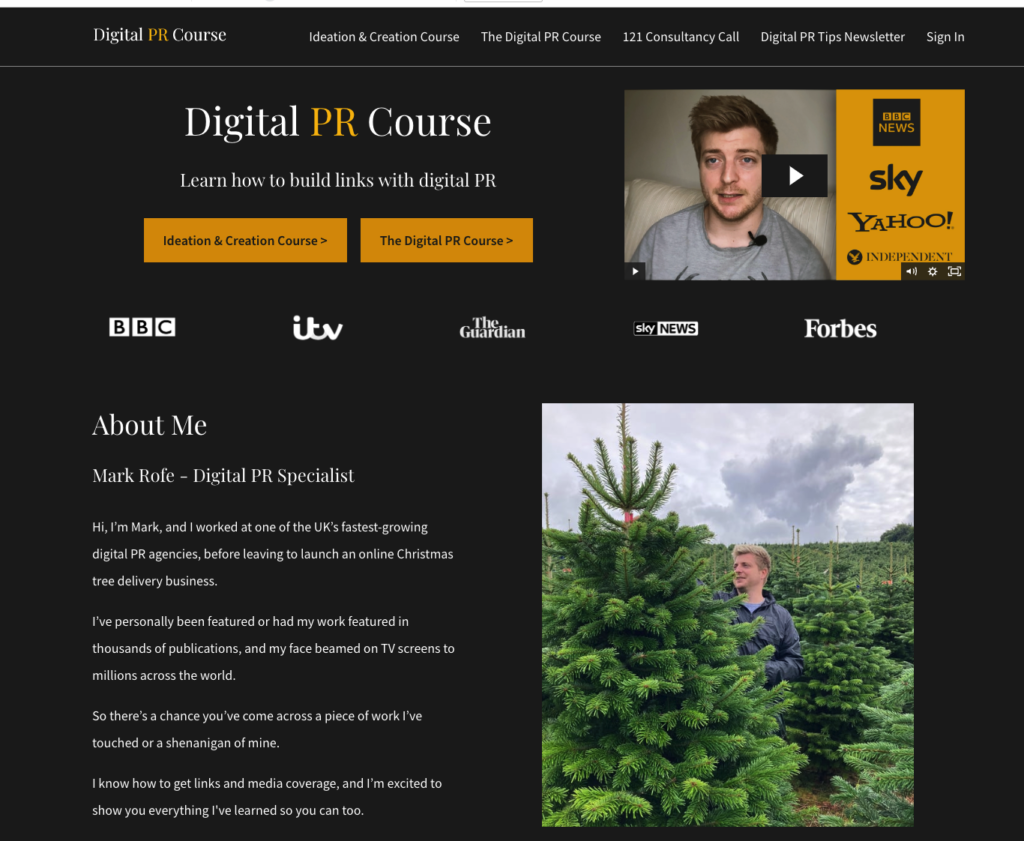
Check out Mark’s digitalprcourse.com
I really wish there was a newsletter like the one I had, um, you know, when I started out, or even now, if someone else created something similar, that that would be great. And I think. It’s, it’s been great for a couple of reasons. Like I like showing people, um, how to do things and I like it when they can go away and do it themselves and kind of get results from it.
But I also think selfishly; it’s made me better at what I do.
It took me maybe a year or 18 months to create this course. But after I’d done it and had to think about how to explain things to people, it made me just, um, Yeah, basically just better at what I do. And that’s now something that I see in my newsletter.
Um, so each week, uh, digitalPRnewsletter.com, you get sent a tip on how to do digital PR or something that will either make your job easier or help you get more coverage. And just by doing that, it’s just, it’s just made me better at what I do. I know that sounds selfish, but, um, but yeah, it’s, it’s for me, but also, um, For people as well.
I want to help people. So it’s kind of twofold there, really.
Where Do You Get Ideas and Inspiration For Your Newsletter?
I mean, is it just all personal anecdotes or, you know, yeah, I’d like to say, yeah, go ahead. Um, yeah, it’s very funny to say, I think, well, it’s anywhere really, to be honest with you, but, um, in terms of what I always tell people about ideation is that you kind of need to, uh, you kind of need some inputs in order to create those outputs.
Um, so really you need to be consuming stuff. You need to be reading things or watching things, or whether it’s in the same industry or something, that’s not a tool. And, you know, I’ll give you an example of that, but, you know, uh, you mentioned earlier, but the, the Warren Buffett analogy that just came about because I was literally watching a documentary about, You know, Warren Buffett, and then I thought, Oh, that’d be interesting.
What if I took that and I applied that to, you know, PR and then there we go. That that’s one idea for, for the newsletter then I thought, you know, what he said was a really good way to kind of explain what to do, but. Sometimes. And also because I know I have this newsletter and I know that each week I need to kind of find some content for it.
And yeah, you know, it goes out every Monday. So some Mondays I’m kind of panicking and I’m like, Oh my God, what am I going to, what am I going to put in there this week? So I have that, but I’m, I’m taking note of what I do during the week. If I just do something a little bit different, um, that works, or if I just discover something completely new, I’m just like, Oh, actually maybe I could put that in the newsletter.
Sorry. It’s coming from anywhere, really. I wish, um, I wish I could give like a, a good like source here. I’ve just taken these ideas from here or there or whatever, but it’s just kind of where it’s come about, really.

 End-to-end outreach workflow
End-to-end outreach workflow



 Check out the BuzzStream Podcast
Check out the BuzzStream Podcast

